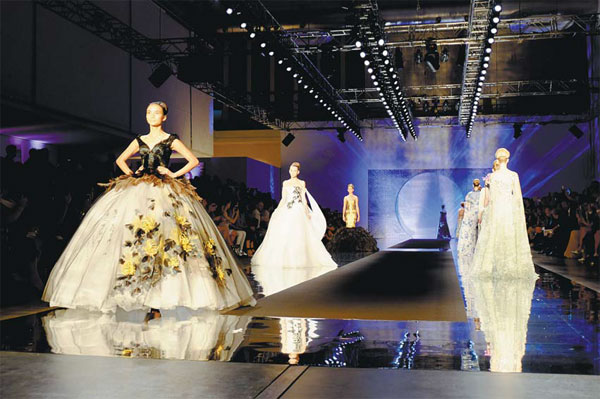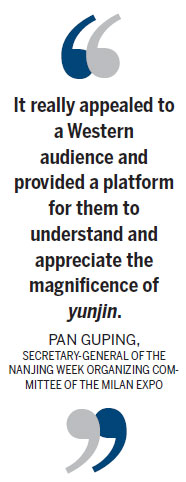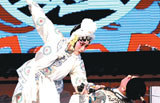Milan show puts Nanjing in spotlight
Updated: 2015-07-17 09:06
By Cecily Liu(China Daily Europe)
|
|||||||||||
European fashionistas get taste of 'royal' Chinese silk brocade as nanjing week opens doors to creative industries
Famous Chinese designer Lawrence Xu amazed a Milan audience with his latest fashion show in mid-July, presenting a collection of more than 40 dresses created by an ancient Chinese weaving technique from Nanjing.
The show, which blends the essence of the yunjin technique with modern, Western-influenced design, is seen as a key milestone in Xu's work. Yunjin is a handmade Chinese silk brocade once reserved for royalty.
 |
|
The fashion show at La Pelota in Milan on July 13 gives a glimpse into the future of yunjin, an ancient Chinese weaving technique. Cecily Liu China Daily. |
Xu has made a name for himself as a high fashion designer, previously exhibiting in 2013 and 2015 at Paris Haute Couture Fashion Week.
The fashion show, which took place on the evening of July 13 at La Pelota in Milan, also encouragingly gave a glimpse into the future of yunjin, and serves as a highlight concluding Nanjing Week at the Milan Expo.
"It really appealed to a Western audience and provided a platform for them to understand and appreciate the magnificence of yunjin. It also showed that yunjin has a future, through international collaboration like this," says Pan Guping, secretary-general of the Nanjing Week Organizing Committee of the Milan Expo.
Nanjing Week was built around yunjin, displaying its past, present and future. A product of Nanjing with a history dating back 1,600 years, yunjin fabric uses precious material, complex techniques and handmade craftsmanship.
Such extensive work means only 300 to 400 meters of Nanjing yunjin is produced every year, resulting in an average daily output of little over one meter in length. The price of yunjin stands at around 15,000 to 20,000 yuan ($2,416 to $3,221) per meter.
Traditionally, yunjin was only used to make clothes for the Chinese royal family, but today it is a symbol of fashion and luxury.
At Nanjing Week, the cloth's heritage was illustrated with displays showing a yunjin hand-operated loom and a royal dragon robe in the City Pavilion, next to the Milan central station. The brocade's present is shown through a 4.7 meter square replica of Leonardo da Vinci's Mona Lisa made in yunjin, allowing an Italian audience to see a familiar work of art in a Chinese artistic medium.
The future was shown through Xu's fashion show, which presents the possibility of the brocade entering the world's most prestigious fashion markets and spread its influence beyond Chinese borders in a tangible and commercial way.

The fashion show featured more than 40 dresses, each blending Chinese and Western culture in its own way.
Some of the designs were heavily influence by qipao, a body-hugging one-piece Chinese dress for women, especially in the treatment of the high neck collar, the short sleeves and the way the top is buttoned up across the chest. The floral patterns in the fabric also are very much inspired by Chinese traditional designs.
At the same time, the cut and shape of the dresses also were suitable for any Western formal occasion, with a look that was modern, bold and creative. Many of the dresses were heavily layered and spread out on the floor. Some had big folds around the waist and others looked like two-piece dresses with the top and skirt made in contrasting colors.
What united the looks was the attention to detail in Xu's design as he worked with the sophisticated design of the brocade fabric. The fabric uses a wide range of colors, from gold to dark blue to red, and often the delicate beading work and embroidery can be seen clearly from a distance.
The yunjin fabric in the show was supplied by the Nanjing Yunjin Research Institute, a company that produces fabric and yunjin crafts and hosts a museum that showcases the history and essence of the fancy silk fabric.
Wu Ying, vice-president of the institute, says her company turned its focus from traditionally produced yunjin crafts to a greater collaboration with the fashion industry in recent years in the hope of increasing the impact and international use of the cloth.
"We want to collaborate with high-end designers like Lawrence Xu through fashion shows so that other international designers all over the world will come to us for their supply of yunjin material, and then we will have made yunjin truly international," Wu says.
The research institute has collaborated with Xu extensively for his fashion shows in 2013 and 2015 at Paris Haute Couture Fashion Week, but Wu says the collaboration in Milan is a breakthrough.
Whereas the previous two shows used the brocade as a part of their collections, so that yunjin dresses were shown alongside clothing made of other fabrics, the Milan show was dedicated to the traditional silk fabric alone. This spotlight on yunjin celebrated its wide range of uses and its dazzling effects in an artistic way, Wu says.
In addition, Xu's continuous work with yunjin allowed the Milan show to better bring out the soul and essence of the fabric and present it to his audience in a more bold, creative and authentic way, Wu says.
"This collection really brings out the best of yunjin, which is defined by its elaborateness, sharp contrast in colors, use of gold and other highly precious threads, and richness in design, which are essentially characteristics that allowed yunjin to become suitable for the royal family in traditional China," Wu says.
But the Milan show wasn't easy to put together. When Wu and Xu found out about the opportunity in February, they had very little time to work on the project.
Wu's staff made hundreds of material samples available, from which Xu chose 20 to 30 fabrics. Wu's craftsmen then worked day and night in three shifts to finish producing the cloth.
"We had so little time, but we had to keep the standards high, which is why some of the clothes were literally made days before Lawrence departed for Milan. But in the end the show was a great success," Wu says.
Future collaborations with designers like Xu could be even more customized because her staff can produce custom fabrics to suit the designer's needs, she says.
In addition, her staff is continuously engaging in research and development work to improve the suitability of yunjin for modern fashion design.
For example, Xu had pointed out that some of the material was not as three-dimensional as he would have liked, which is why he had to add embroidery on top of the fabric. Since then, Wu's staff has worked to find a suitable way of producing more three-dimensional yunjin fabrics.
The show certainly grabbed the attention of its Italian audience, gauging from the loud cheers and applause.
"I've never seen anything like this. I liked every single dress and the show was wonderful," says Elisabetta Colombo, a public relations specialist based in Milan.
Colombo says she found the dresses to be very international. Although the fabric and patterns were heavily influenced by Chinese culture, the cut, shape and design were very Western in the sense one could comfortably wear the dresses on many occasions in Europe.
Pan says Nanjing Week was effective in promoting the best of the city to an international audience in Milan for the expo.
In addition to the temporary exhibitions and events during the week, his staff also established a subsidiary of Nanjing Creative Design Center - a public service organization supported by the Nanjing municipal government - giving it a permanent office in Milan. It was established to help creative industry firms from the two cities do business with each other.
Many Nanjing companies also visited Milan during the week to discuss potential business partnerships with their Italian counterparts. One example is Nanjing Baoqing Jewelry Corp, which sponsored jewelry for Xu's fashion show. Yin Shunrong, general manager of the company, says his staff was in Milan to look for business partners in the design and manufacturing of jewelry.
"We have always been outward looking since we started to import jewelry-making machines from Italy in the 1980s, and now we want to make our designs more international and start to venture into the overseas market in terms of sales," Yin says.
Pan's staff is also in the process of organizing an exhibition in Nanjing for later this year. It would showcase a wide range of the best design collaborations between companies and designers from Nanjing and Milan who have inspired each other and together produced designs that highlight the creative industries of both cities.
Nanjing Week coincided with Jiangsu Culture Week, which began on July 6. That showcase began with a formal opening ceremony in Milan, including a performance of the Jiangsu folk song Jasmine Flower.
Jiangsu folk artists also presented the province's intangible cultural heritage, such as Yangzhou paper-cutting artwork and Suzhou embroidery.
To celebrate the 45th anniversary of diplomatic relations between China and Italy, Jiangsu created an especially commissioned opera performance shown in Milan on July 15 and 16.
cecily.liu@chinadaily.com.cn
Today's Top News
China, World Bank pledge $50m for poor
China's stock wobbles may deter foreign investors - for now
Europe moves to restore funding to Greece after bailout vote
Low fertility rate hampers NE China's development
Industries should be on digital Silk Road
'Occupy Central' leaders to stand trial
MH17 final report to be published in October
ECB raises Greek bank funding as Europe backs new loan
Hot Topics
Lunar probe , China growth forecasts, Emission rules get tougher, China seen through 'colored lens', International board,
Editor's Picks

|

|

|

|

|

|






